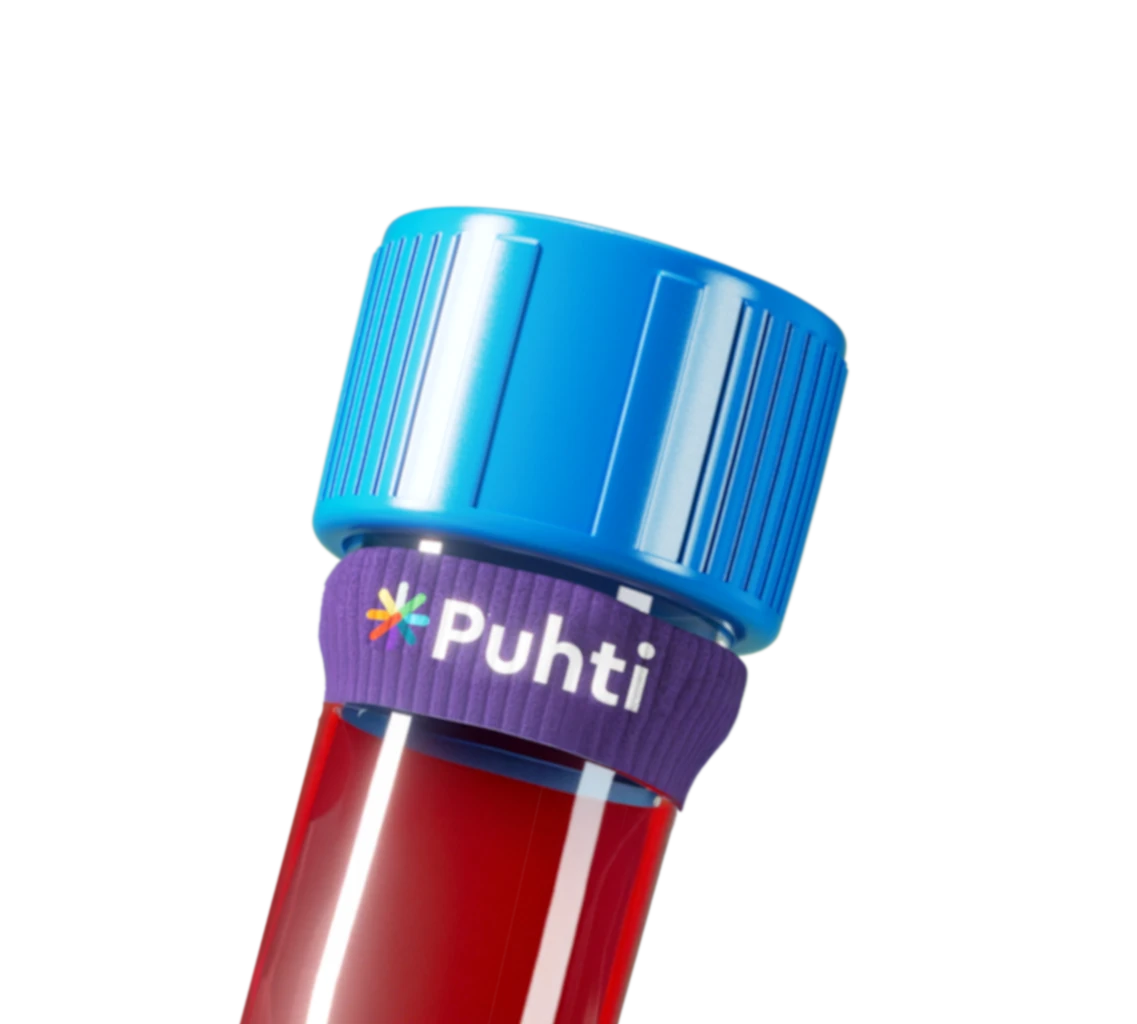
Iron (Fe) affects your coping, well-being and mood
Iron is essential for the body. It affects many bodily functions. One of its main tasks is to transport oxygen to important organs such as the heart and muscles.

Iron (Fe) affects your coping, well-being and mood
Iron is essential for the body. It affects many bodily functions. One of its main tasks is to transport oxygen to important organs such as the heart and muscles.
Iron is essential
- Iron acts as an oxygen-binding component in red blood cells’ hemoglobin.
- Recommended iron intake is higher for women than for men.
- The best sources of dietary iron are liver, meat, and whole grain products.
- Iron deficiency is the most common cause of anemia.
Iron is essential for the body
Iron is an essential mineral, more specifically a micronutrient, for the body. It affects many bodily functions. One of its main tasks is to transport oxygen to important muscles and organs, such as the heart.
Normal iron values help to prevent anemia and to stay refreshed and healthy. Low iron values lead to poor health but, on the other hand, high values can also cause health problems.
The body cannot produce iron, so it must be obtained from food every day. Iron is eliminated from the body with secretions which is why regular intake is important.
Iron deficiency is the most common nutrient deficiency in the world.
Functions of iron
The main function of iron is to participate in the transport of oxygen as a component of red blood cells’ hemoglobin.
Why is iron intake so important?
Adequate iron intake ensures normal energy levels and coping. Iron must be obtained through food every day as our bodies cannot produce it. Ferritin is the primary test if iron deficiency is suspected.
Storage of iron
The majority of the body’s iron is functional, usable iron. However, iron is also stored in ferritin. In addition to many other factors, the amount of iron stored in the body is influenced by the time of day and, in women, the stage of the menstrual cycle. In other words, the iron content in the body is not constantly the same.
Iron absorption is complex
Although iron is obtained from food, its absorption in the body may be poor. Iron is absorbed in the small intestine which plays an important role in regulating the amount of iron in the body. Coeliac disease and other conditions related to malabsorption, for example, can affect the absorption of iron.
In coeliac disease, the protein gluten contained in rye, wheat and barley, damages the villi in the mucous membrane of the small intestine leading to poor absorption and deficiency of nutrients such as iron. The method of treating iron deficiency is determined according to the causes of the condition. If the cause is coeliac disease, it must be treated appropriately which can also support the absorption of iron in the future. You can also access coeliac disease tests via Puhti without a referral.
Vitamin C helps the absorption of iron. When eating iron-rich foods or iron supplements, you should also ensure proper vitamin C intake, from fruits or berries, for example. Many iron supplements also contain vitamin C.
Certain foods and beverages inhibit the absorption of iron. Calcium (contained in dairy products or calcium-enriched plant-based drinks such as oat drinks), magnesium supplements, coffee, and tea impair the absorption of iron, which is why iron supplements should not be taken when eating or drinking these.
Certain medications may also interfere with the absorption of iron. Consult your doctor for detailed instructions.
Iron is best absorbed when iron stores are scarce. As the level of iron in the body increases, absorption gradually diminishes.
Iron level tests
The two most common blood tests used to assess iron levels are hemoglobin (B-Hb) and ferritin (S-Ferrit) tests. Iron test fP-Fe is also available, but when assessing iron deficiency, hemoglobin and ferritin are more important. An iron test (fP-Fe) is primarily carried out as an additional test when determining the transferrin saturation.
The hemoglobin (B-Hb) test is the most common blood test in healthcare. It is used to diagnose iron deficiency anemia. Hemoglobin is part of the blood count.
Reasons for performing a ferritin test:
- assessment of the body’s iron levels
- diagnosis of iron deficiency if the person has anemia or belongs to a high-risk group
- differential diagnosis of the cause of anemia
- monitoring of iron supplement treatment, in case iron supplement has been used to treat iron deficiency and the effectiveness of the treatment needs to be monitored
- people at risk of iron deficiency: pregnant women, the elderly, blood donors, people on strictly vegetarian diet and people with intestinal diseases.
Instead of just measuring ferritin, you should always also check your CRP and blood count. The CRP test indicates the inflammatory state of the body.
Iron intake
Normal iron values help to prevent anemia and to stay refreshed and healthy. Heavy menstruation commonly leads to iron deficiency.
In Finland, men get enough iron from their diet on average, but the intake of iron among women often falls short of the recommendations. According to the FinRavinto 2017 study, only five per cent of men had lower iron intake than the average need. The majority of women received iron below the recommendations. Iron intake generally ranged from about 5–20 mg among men to about 5–18 mg among women.
The most important source of dietary iron for both men and women was cereals while meat and egg dishes came second.
How much iron is needed from diet?
The recommended intake of iron for men is 9 mg/day and 15 mg/day for women of reproductive age. The required iron intake for postmenopausal women is only 9 mg/day, which is also the level recommended for men.
The recommended intake for women is higher than for men due to menstruation. A lot of iron is lost during menstruation. Some women may have such heavy periods that a daily dose of 15 milligrams of iron is not enough.
The need for iron increases during pregnancy. Pregnant women are recommended by the maternity clinic staff to take iron supplements, if necessary. A daily iron intake of 15 mg is recommended for breastfeeding women. The maternity clinic monitors the hemoglobin value, which is an indicator of anemia.
On average, only 15% of the iron in food is absorbed, which is taken into account in the iron intake recommendations.
You can estimate your own iron intake with the Finel calculator, for example, but this does not really tell you how much iron you actually absorb from your diet. This is a rough estimate. A better way to look at your iron intake is to monitor your own blood values and the body’s iron stores.
Recommended iron intake for children varies with age
| Age | Recommended intake of iron, mg/day |
| <5 years | 8 |
| 6-9 years | 9 |
| 10-13 years | 11 |
| 14-17 years, boys | 11 |
| 14-17 years, girls | 15 |
Iron deficiency is a common problem
Iron deficiency may occur if:
- there is not enough iron in the diet
- there is insufficient absorption of iron
- a lot of iron is lost
What are the causes of iron deficiency?
Low iron values can be caused by, for example:
- low dietary iron intake
- blood loss due to menstruation, repeated blood donations, bleeding, childbirth or, for example, an ulcer in the digestive system
- a child’s rapid growth
- malabsorption disorders such as coeliac disease (insufficient iron absorption)
- pregnancy (increased need for iron)
- physical activity (increased need for iron).
Iron deficiency is treated according to the cause. Iron stores can be replenished with food and, if necessary, iron supplements. If iron deficiency is caused by an illness, it must be treated.
What are the high-risk groups for iron deficiency?
Certain people are at a higher risk of receiving too little iron from their diet. Low iron intake can develop into iron deficiency anemia.
Pay particular attention to your iron values and iron intake if you belong to the following groups:
- Women of reproductive age – menstruation depletes your iron stores every month. Heavy menstrual bleeding can cause severe iron deficiency.
- People with unvaried diets. A varied diet is the most important way to prevent iron deficiency.
- Pregnant and breastfeeding mothers: pregnancy itself increases the need for iron while the mother must also get sufficient iron for the child.
- Children, especially adolescent girls
- Physically very active people and athletes
- People with coeliac disease or other malabsorption syndromes
- People with inflammatory bowel disease
- People who have experienced heavy bleeding, for example, due to accidents, surgery or childbirth.
- Persons who have repeatedly donated blood.
- The elderly
- People on a vegetarian or vegan diet should pay attention not only to their iron intake but also its absorption. However, iron deficiency is typically associated with heavy menstrual bleeding and not whether or not the diet includes animal products.
What are the consequences of iron deficiency?
Low iron levels can cause a wide range of symptoms. Iron deficiency is the most common cause of anemia. However, anemia may be associated with lack of vitamin B12 and folic acid. The symptoms develop unnoticed and it is possible to get used to them and think that they are part of normal life.
Iron deficiency anemia may be associated with the following symptoms:
- tiredness
- poor physical performance and general condition
- palpitations
- shortness of breath
- dizziness
- weakness
- paleness, pale gums
- headache
- ringing in the ears
- hair loss and thinning, poor nail and skin condition
- restless legs
- oral symptoms, such as the sensation of a lump in the throat, ulcers in the mouth and corners of the mouth, lingual papillae lesions, tongue pain, difficulty swallowing
- sleep disorders
- depression-like symptoms
The more severe the anemia, the stronger the symptoms.
These symptoms may also be related to another condition or disease. If you suspect an illness or have symptoms, seek medical attention directly.
Is it possible to get too much iron?
Excessive intake of iron is extremely rare, but it is possible in principle. In general, it is not possible to get too much dietary iron. Excess intake is usually associated with a disorder of iron absorption (in which case too much iron is absorbed) or the use of an iron supplement (oral supplement or intravenous iron infusion).
Iron can accumulate in the body. In most cases, repeated blood transfusions are responsible for excess intake of iron and the use of iron supplements is rarely the reason behind it. The maximum dose of the iron supplement should not be exceeded. In the case of children, in particular, iron supplements should be used with care and the instructions given by the doctor must be followed.
Excessive iron intake can weaken the immune mechanisms of the body. Therefore, excessive iron increases the risk of infections to some extent.
If a dietary supplement or other iron-based products are used moderately, it is unlikely that too much iron would accumulate in the body.
An example of the adverse effects of iron is hereditary hemochromatosis. Hemochromatosis is a condition in which the body stores too much iron. The condition stems from a gene mutation that increases the absorption of iron through the intestines.
What are the sources of iron? Best sources of dietary iron
The best sources of dietary iron are liver, meat and whole grain products. According to the FinRavinto 2017 study, the most important source of dietary iron for both men and women was cereals while meat and egg dishes came second.
What are good sources of dietary iron?
The following foods, for example, are great sources of iron (amount per 100 g of food):
- Blood and liver dishes (blood pancakes 21.6 mg, liver 14.7 mg)
- Bran, flakes and groats high in fibre
- Pumpkin seed 10.3 mg, sesame seed 9.1 mg and hemp seed 13 mg
- Lentils 7.6–11.1 mg
- Black beans 8.7 mg, white beans 6.1 mg, brown beans 5.2 mg, soybeans 8.4 mg and broad beans 6.7 mg
- Black sausage 7.5 mg
- Bovine liver 7.2 mg
- Nuts (especially cashew nuts 6 mg) and almonds 5.2 mg
- Chickpeas 5.5 mg
- Liver sausage 5.5 mg
- Game meat 5.4 mg
- Fried venison 4.8 mg
- Quinoa 4.6 mg
- Beef roast 4.4 mg
- Liver casserole 3.1–4.1 mg
- Minced meat 3.1 mg
- Tuna
- Spinach, nettle and arugula
- Pasta, potatoes and rice
- Eggs
- Clams, crustaceans and fish
- Broccoli, pea, Jerusalem artichoke and black root
- Dried basil and oregano
- Plums
Which foods support the absorption of iron the best?
Iron (heme iron) is best absorbed from animal products, but it is also possible to get enough iron from plant products (non-heme iron).
What are the sources of iron for vegetarians?
Vegetarians and vegans can get enough iron from their diet. Vegetarians should pay attention to the absorption of iron in addition to iron-rich foods (for example, avoiding coffee, tea and dairy products when eating iron-rich foods).
The following plant-based foods contain iron, among others:
- hemp seeds 13 mg
- poppy seeds 10.8 mg
- pumpkin seeds 10.3 mg
- chia seeds 9.6 mg
- sesame seeds 9.1 mg and tahini or sesame seed paste 10.6 mg
- lentils 7.6–11.1 mg
- boletus pinetorum 10 mg
- soybeans 8.4 mg and soy products (such as tofu 4.8 mg, soybean protein powder 10.8 mg, soybean meal 13.7 mg and soybean flour 9.1 mg)
- black beans 8.7 mg, white beans 6.1 mg, brown beans 5.2 mg and broad beans 6.7 mg
- linseed 8.2 mg
- pine nuts 6.7 mg
- pulled oats 6 mg
- cashew nuts 6 mg
- sunflower seeds 5.7 mg
- bran, flour and flakes (e.g. oatmeal 5.5 mg)
- pea shoots 5.5 mg
- chickpeas 5.5 mg
- almonds 5.2 mg
- peas 4.8 mg
- quinoa 4.6 mg
- pasta, spaghetti, macaroni 4.4 mg
- pistachios 4.2 mg
- whole grain products, whole grain bread and whole grain pasta
- seed mixes and crisp seed breads
What promotes the absorption of dietary iron?
Foods containing iron should be accompanied by foods rich in vitamin C, such as vegetables and fruits, as vitamin C promotes the absorption of iron. For example, blackcurrants contain a lot of vitamin C.
What restricts the absorption of dietary iron?
Certain nutrients restrict the absorption of iron, for example the calcium contained in dairy products, magnesium supplements, coffee, tea and brans. If the aim is to increase iron levels, these foods should be consumed separately from iron-rich foods.
Iron supplements should usually be taken with an empty stomach.
How do iron stores affect iron absorption?
The absorption of iron is improved when body’s iron stores decrease. In turn, higher iron stores effectively reduce the absorption of iron.
What is heme iron?
The heme iron contained in meat and fish is better absorbed than the iron contained in plant-based foods. Heme iron is only found in products of animal origin.
What is non-heme iron?
Non-heme iron is found in plant products. The heme iron from animal products is better absorbed than the non-heme iron from plant products.




